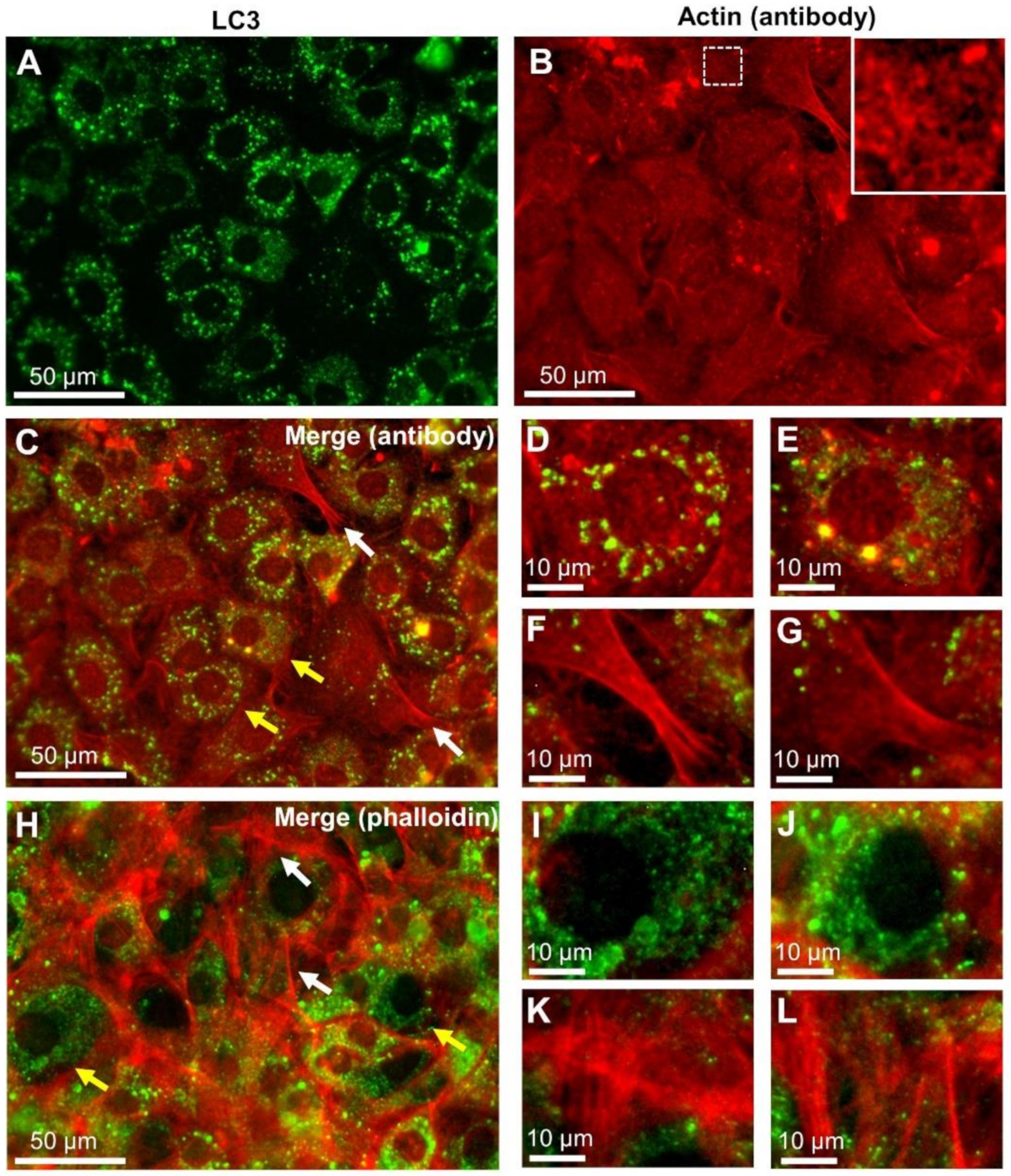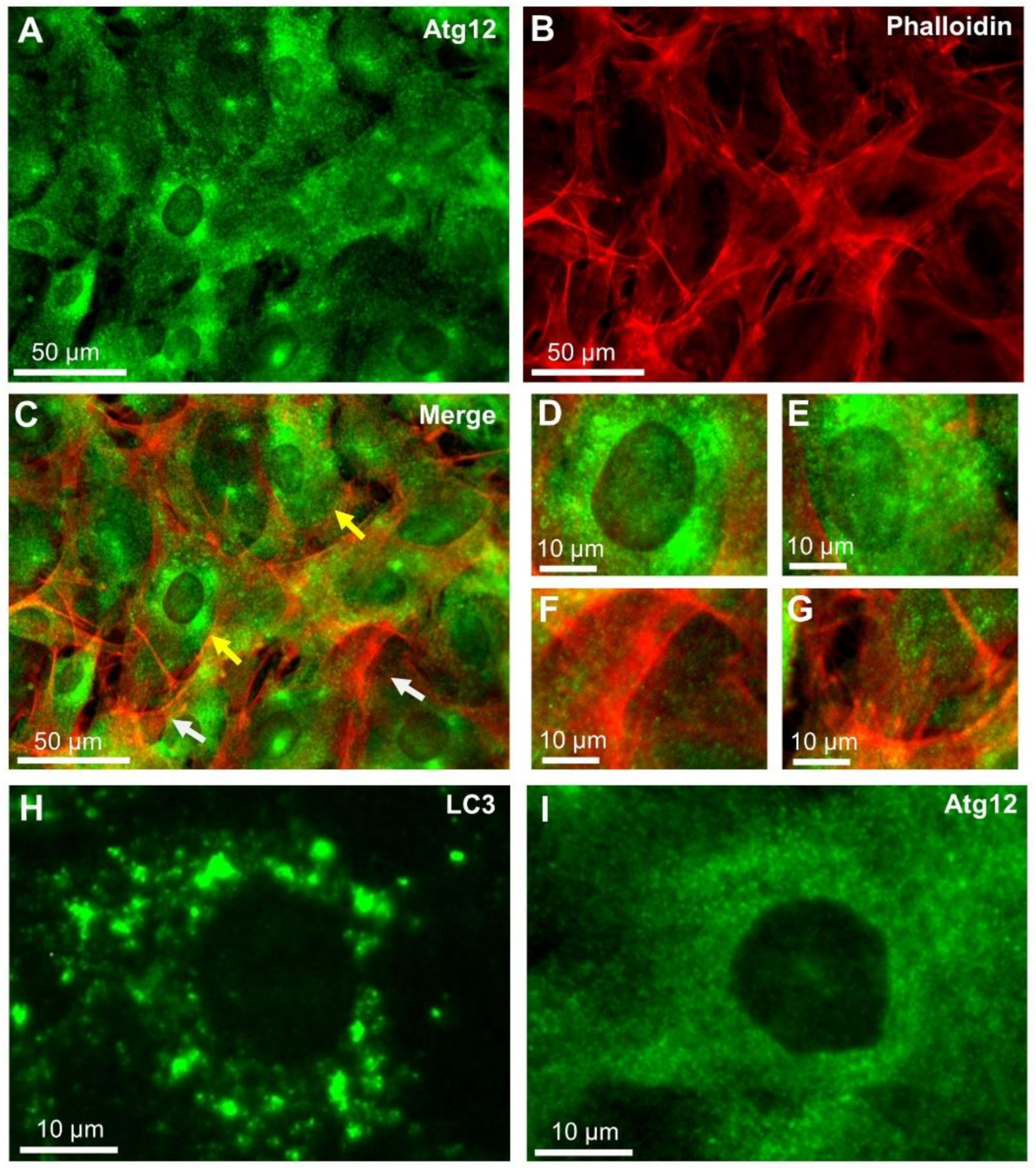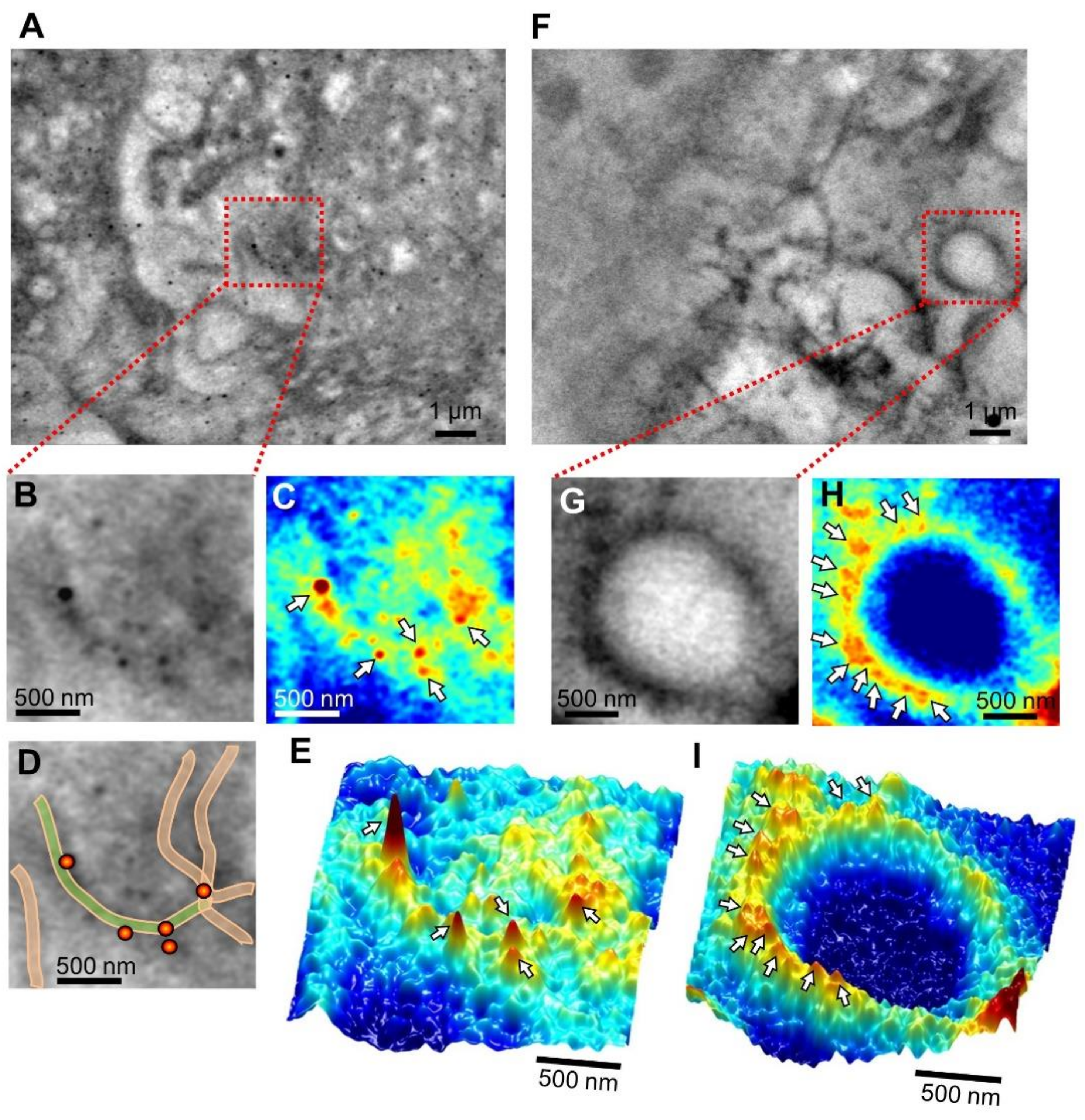Scanning Electron-Assisted Dielectric Microscopy Reveals Autophagosome Formation by LC3 and ATG12 in Cultured Mammalian Cells
Abstract
1. Introduction
2. Results
2.1. Localisation of LC3 and Actin in Cultured Cells Using Fluorescence Microscopy
2.2. Localisation of Atg12 and Actin in Cultured Cells Using Fluorescence Microscopy
2.3. SE-ADM Analysis of the Localisation of LC3, Atg12 and Actin in Cultured Cells
3. Discussion
4. Materials and Methods
4.1. Liquid Samples and the Culture Dish Holder
4.2. Sample Preparation of 4T1E/M3 Cells and Rat Embryonic Fibroblasts
4.3. Immunofluorescence Staining of the Cells and Observation under an Optical Microscope
4.4. Immunolabelling of Cells Using Antibody and 60 nm Colloidal Gold Particles
4.5. High-Resolution SE-ADM System and FE-SEM Setup
4.6. Image Processing
4.7. Calculation of Minimum Interval Between Colloidal Gold Particles
5. Conclusions
Supplementary Materials
Author Contributions
Funding
Institutional Review Board Statement
Informed Consent Statement
Data Availability Statement
Acknowledgments
Conflicts of Interest
Abbreviations
| AD | Analog-digital |
| Al | Aluminum; |
| Atg12 | Conserved autophagy-related gene 12 |
| EB | Electron beam |
| FITC | Fluorescein isothiocyanate |
| GF | Gaussian filter |
| LC3 | Microtubule-associated proteins 1A/1B light chain 3 |
| LPF | Low-pass filtered |
| OM | Optical microscope |
| REF | Rat embryonic fibroblasts |
| SE-ADM | Scanning electron-assisted dielectric microscopy |
| SEM | Scanning electron microscopy |
| SiN | Silicon nitride |
| W | Tungsten |
References
- Mizushima, N. Autophagy: Process and function. Genes Dev. 2007, 21, 2861–2873. [Google Scholar] [CrossRef]
- Mizushima, N.A.; Levine, B.; Cuervo, A.M.; Klionsky, D.J. Autophagy fights disease through cellular self-digestion. Nature 2008, 451, 1069–1075. [Google Scholar] [CrossRef]
- Coutts, A.S.; La Thangue, N.B. Regulation of actin nucleation and autophagosome formation. Cell. Mol. Life Sci. 2016, 73, 3249–3263. [Google Scholar] [CrossRef]
- Levine, B.; Kroemer, G. Biological Functions of Autophagy Genes: A Disease Perspective. Cell 2019, 176, 11–42. [Google Scholar] [CrossRef]
- Kuma, A.; Komatsu, M.; Mizushima, N. Autophagy-monitoring and autophagy-deficient mice. Autophagy 2017, 13, 1619–1628. [Google Scholar] [CrossRef]
- Demarchi, F.; Bertoli, C.; Copetti, T.; Tanida, I.; Brancolini, C.; Eskelinen, E.-L.; Schneider, C. Calpain is required for macroautophagy in mammalian cells. J. Cell Biol. 2006, 175, 595–605. [Google Scholar] [CrossRef]
- Xie, Z.; Klionsky, D.J. Autophagosome formation: Core machinery and adaptations. Nat. Cell Biol. 2007, 9, 1102–1109. [Google Scholar] [CrossRef]
- Boya, P.; Reggiori, F.; Codogno, P. Emerging regulation and functions of autophagy. Nat. Cell Biol. 2013, 15, 713–720. [Google Scholar] [CrossRef]
- Kabeya, Y.; Mizushima, N.; Yamamoto, A.; Oshitani-Okamoto, S.; Ohsumi, Y.; Yoshimori, T. LC3, GABARAP and GATE16 localize to autophagosomal membrane depending on form-II formation. J. Cell Sci. 2004, 117, 2805–2812. [Google Scholar] [CrossRef]
- Tanida, I.; Ueno, T.; Kominami, E. LC3 conjugation system in mammalian autophagy. Int. J. Biochem. Cell Biol. 2004, 36, 2503–2518. [Google Scholar] [CrossRef]
- Mizushima, N.; Sugita, H.; Yoshimori, T.; Ohsumi, Y. A new protein conjugation system in human—The counterpart of the yeast Apg12p conjugation system essential for autophagy. J. Biol. Chem. 1998, 273, 33889–33892. [Google Scholar] [CrossRef]
- Geng, J.; Klionsky, D.J. The Atg8 and Atg12 ubiquitin-like conjugation systems in macroautophagy. EMBO Rep. 2008, 9, 859–864. [Google Scholar] [CrossRef]
- Jounai, N.; Takeshita, F.; Kobiyama, K.; Sawano, A.; Miyawaki, A.; Xin, K.-Q.; Ishii, K.J.; Kawai, T.; Akira, S.; Suzuki, K.; et al. The Atg5 Atg12 conjugate associates with innate antiviral immune responses. Proc. Natl. Acad. Sci. USA 2007, 104, 14050–14055. [Google Scholar] [CrossRef]
- Otomo, C.; Metlagel, Z.; Takaesu, G.; Otomo, T. Structure of the human ATG12~ATG5 conjugate required for LC3 lipidation in autophagy. Nat. Struct. Mol. Biol. 2013, 20, 59–66. [Google Scholar] [CrossRef]
- Rubinstein, A.D.; Eisenstein, M.; Ber, Y.; Bialik, S.; Kimchi, A. The Autophagy Protein Atg12 Associates with Antiapoptotic Bcl-2 Family Members to Promote Mitochondrial Apoptosis. Mol. Cell 2011, 44, 698–709. [Google Scholar] [CrossRef]
- Dooley, H.C.; Razi, M.; Polson, H.E.J.; Girardin, S.E.; Wilson, M.I.; Tooze, S.A. WIPI2 links LC3 conjugation with PI3P, Autophagosome formation, and pathogen clearance by recruiting Atg12-5-16L1. Mol. Cell 2014, 55, 238–252. [Google Scholar]
- Biazik, J.; Vihinen, H.; Anwar, T.; Jokitalo, E.; Eskelinen, E.-L. The versatile electron microscope: An ultrastructural overview of autophagy. Methods 2015, 75, 44–53. [Google Scholar] [CrossRef]
- Coutts, A.S.; La Thangue, N.B. Actin nucleation by WH2 domains at the autophagosome. Nat. Commun. 2015, 6, 7888. [Google Scholar] [CrossRef]
- Ligeon, L.A.; Barois, N.; Werkmeister, E.; Bongiovanni, A.; Lafont, F. Structured illumination microscopy and cor-relative microscopy to study autophagy. Methods 2015, 75, 61–68. [Google Scholar] [CrossRef]
- Ogura, T. Direct Observation of Unstained Biological Specimens in Water by the Frequency Transmission Electric-Field Method Using SEM. PLoS ONE 2014, 9, e92780. [Google Scholar] [CrossRef]
- Ogura, T. Nanoscale analysis of unstained biological specimens in water without radiation damage using high-resolution frequency transmission electric-field system based on FE-SEM. Biochem. Biophys. Res. Commun. 2015, 459, 521–528. [Google Scholar] [CrossRef]
- Okada, T.; Ogura, T. Nanoscale imaging of untreated mammalian cells in a medium with low radiation damage using scanning electron-assisted dielectric microscopy. Sci. Rep. 2016, 6, 29169. [Google Scholar] [CrossRef]
- Okada, T.; Ogura, T. High-resolution imaging of living mammalian cells bound by nanobeads-connected antibodies in a medium using scanning electron-assisted dielectric microscopy. Sci. Rep. 2017, 7, srep43025. [Google Scholar] [CrossRef]
- Okada, T.; Ogura, T. Nanoscale imaging of the adhesion core including integrin beta 1 on intact living cells using scanning electron-assisted dielectric-impedance microscopy. PLoS ONE 2018, 13, e0204133. [Google Scholar] [CrossRef]
- Okada, T.; Iwayama, T.; Murakami, S.; Torimura, M.; Ogura, T. Nanoscale observation of PM2.5 incorporated into mammalian cells using scanning electron-assisted dielectric microscope. Sci. Rep. 2021, 11, 228. [Google Scholar] [CrossRef]
- Land, H.; Parada, L.F.; Weinberg, R.A. Tumorigenic conversion of primary embryo fibroblasts requires at least two cooperating oncogenes. Nature 1983, 304, 596–602. [Google Scholar] [CrossRef]
- Kast, D.J.; Dominguez, R. The Cytoskeleton–Autophagy Connection. Curr. Biol. 2017, 27, R318–R326. [Google Scholar] [CrossRef]
- Aguilera, M.O.; Berón, W.; Colombo, M.I. The actin cytoskeleton participates in the early events of au-tophagosome formation upon starvation induced autophagy. Autophagy 2012, 8, 1590–1603. [Google Scholar] [CrossRef]
- Takahashi, M.; Furihata, M.; Akimitsu, N.; Watanabe, M.; Kaul, S.; Yumoto, N.; Okada, T. A highly bone marrow metastatic murine breast cancer model established through in vivo selection exhibits enhanced anchor-age-independent growth and cell migration mediated by ICAM-1. Clin. Exp. Metastasis 2008, 25, 517–529. [Google Scholar] [CrossRef]
- Takahashi, M.; Miyazaki, H.; Furihata, M.; Sakai, H.; Konakahara, T.; Watanabe, M.; Okada, T. Chemokine CCL2/MCP-1 negatively regulates metastasis in a highly bone marrow-metastatic mouse breast cancer model. Clin. Exp. Metastasis 2009, 26, 817–828. [Google Scholar] [CrossRef]
- Sakai, H.; Furihata, M.; Matsuda, C.; Takahashi, M.; Miyazaki, H.; Konakahara, T.; Imamura, T.; Okada, T. Aug-mented autocrine bone morphogenic protein (BMP) 7 signaling increases the metastatic potential of mouse breast cancer cells. Clin. Exp. Metastasis 2012, 29, 327–338. [Google Scholar] [CrossRef]




Publisher’s Note: MDPI stays neutral with regard to jurisdictional claims in published maps and institutional affiliations. |
© 2021 by the authors. Licensee MDPI, Basel, Switzerland. This article is an open access article distributed under the terms and conditions of the Creative Commons Attribution (CC BY) license (http://creativecommons.org/licenses/by/4.0/).
Share and Cite
Okada, T.; Ogura, T. Scanning Electron-Assisted Dielectric Microscopy Reveals Autophagosome Formation by LC3 and ATG12 in Cultured Mammalian Cells. Int. J. Mol. Sci. 2021, 22, 1834. https://doi.org/10.3390/ijms22041834
Okada T, Ogura T. Scanning Electron-Assisted Dielectric Microscopy Reveals Autophagosome Formation by LC3 and ATG12 in Cultured Mammalian Cells. International Journal of Molecular Sciences. 2021; 22(4):1834. https://doi.org/10.3390/ijms22041834
Chicago/Turabian StyleOkada, Tomoko, and Toshihiko Ogura. 2021. "Scanning Electron-Assisted Dielectric Microscopy Reveals Autophagosome Formation by LC3 and ATG12 in Cultured Mammalian Cells" International Journal of Molecular Sciences 22, no. 4: 1834. https://doi.org/10.3390/ijms22041834
APA StyleOkada, T., & Ogura, T. (2021). Scanning Electron-Assisted Dielectric Microscopy Reveals Autophagosome Formation by LC3 and ATG12 in Cultured Mammalian Cells. International Journal of Molecular Sciences, 22(4), 1834. https://doi.org/10.3390/ijms22041834





